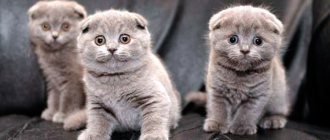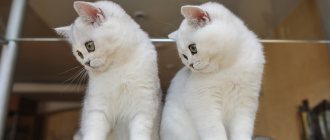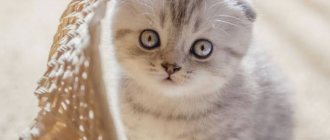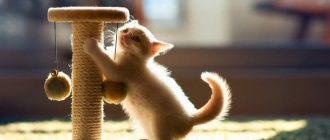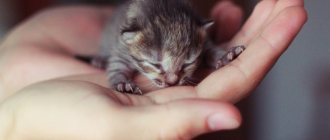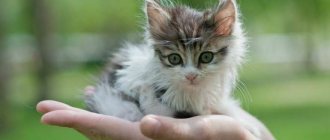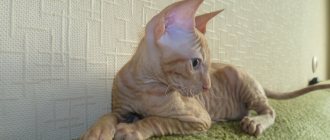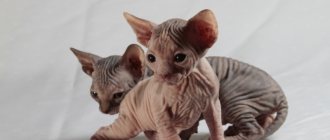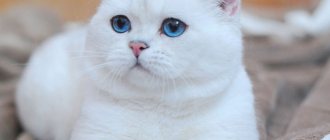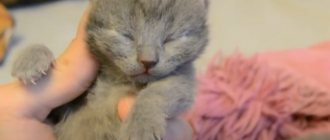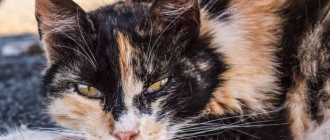Preparing for the arrival of a British kitten in the house. Selection of toys, bedding, tray and filler. How to toilet train your pet? Proper feeding with natural and prepared foods.
The British kitten is distinguished by thick paws, a round muzzle and large amber eyes. In whites they can be blue, but they are found with a green iris. Their fur is soft and fluff-like.
They are born weighing 60-140 g. By the end of the first month, the figures are comparable, but the cats are slightly smaller. By six months, the body weight of a little Briton reaches 2-5 kg. They weigh up to 6-7 kg per year, and final formation occurs in 2-3 years.
During this time, their need for food increases, but their activity decreases. In the first months, they play almost all the time they have free from sleep. This is how they learn about the world; the cat teaches them how to defend themselves and attack. With their brothers and sisters they learn the rules of communication.
British breed kittens are affectionate, but not tame. They devote a lot of time to rest. They can fall asleep in the middle of the game, immediately after eating. Up to 5 months it is easy to teach them any rules. It is important not to miss this moment.
What to prepare for the kitten's arrival
If the choice of the future pet has already been made, all that remains is to wait until it grows a little and can leave the nursery. It is necessary to prepare and foresee a lot for his arrival.
First of all, buy:
- carrying;
- a house or bed for sleeping;
- scratching post;
- bowls and food containers;
- dry and wet food;
- litter tray;
- filler;
- toys;
- accessories and grooming products.
Carrying
Carrying is necessary for safe transportation. They will not allow you to pick up an animal from a professional nursery in her absence. Moreover, this item will come in handy more than once in the future - when traveling to the veterinarian, to the country, or on vacation to another city or country.
Pet stores now offer a large selection of carriers of different sizes and from a variety of materials - rag, in the form of bags made of leatherette and plastic.
The latter option is preferable, as it has a large internal volume, rigid and durable walls, and retains its shape. If in the future it is possible to fly with your pet on an airplane, then you need to choose exactly this model, since airlines have special requirements for the luggage container.
It’s better to immediately choose a fairly expensive carrier, with a metal door and strong fastenings. You should not buy a small one, the baby will grow within a year, and adult British cats can reach a weight of six kilograms. Estimated price - 2-3 thousand rubles.
At first, with the door removed, the plastic carrier can also serve as a place to sleep.
Cat house and scratching post
In specialized stores, you can choose an option that will suit everyone - it will suit your pet in size and fit well into the interior of the house. There are many options for cat houses.
The most convenient one for a Briton is a small one on a round stand, which also serves as a scratching post. This breed is not very active and large play structures will not attract the kitten's attention.
The preferred upholstery option for the house is carpet; it washes best and lasts longer. The rope on the scratching post should preferably be jute. Although at first there will be a little garbage from it, any cats give it preference over other options and willingly sharpen their claws.
This design can be purchased for 4 thousand rubles.
You can get by with a bed, but this is a less convenient option. It wears out faster and requires frequent washing. The minimum cost is 1000 rubles. And in this case you will have to buy a scratching post separately. A small corner corner made of carpet will also not cost less than a thousand. But it quickly breaks down, and kittens are not too fond of such material.
Bowls and food containers
Among the huge variety of cat dishes, you should choose one that is comfortable for your pet and made from safe materials. This is stainless metal and earthenware.
A double bowl on an adjustable stand for water and dry food is very practical. You can buy a separate earthenware plate for wet and natural food. All three will cost 1-1.5 thousand rubles if chosen correctly.
The height-adjustable stand is very convenient - for a kitten you can lower the bowls to the lowest level, for an adult cat you can raise them. This accessory is pet-friendly and stable - it won't slide on the floor when the animal is eating.
A small container for food is also desirable; you can pour dry mixture (0.5-1 kg) into it and always keep it in the kitchen. It is usually made of metal and beautifully designed. This accessory is inexpensive - from 200 rubles.
Stern
First of all, you need to ask the breeder what kind of diet the British baby had in the nursery. For the first time, it is necessary to purchase exactly the food that the kitten is accustomed to.
If the desire arises, you can gradually transfer it to another, but not in the first days after the move.
Several bags of high-quality wet food are also necessary, even if you do not feed them to the animal in the future. In the first days at home, the baby will experience stress and may refuse to eat. This delicacy usually creates an appetite.
The cost of super premium food starts from about 500 rubles per 1 kg.
Toilet and litter
The acquisition of these important items must be taken seriously. First of all, find out from the breeder what kind of toilet and litter the British kitten uses in the nursery.
Experienced breeders never set up a separate small tray for babies; kittens, looking at their mother, begin to go to the same toilet as her.
Usually in nurseries they use closed toilets of the “house” type. They often consist of two compartments, one of which contains a grid for cleaning the paws. Such a toilet is not cheap and can cost about 5 thousand rubles, but it is made of high-quality plastic that is easy to clean, will never break and has bactericidal properties (with silver ion deposition).
They are usually equipped with special filters for air purification.
For small kittens, wood filler is preferable; most likely, this is what the baby is used to in the nursery. This is the most inexpensive and safest option. A 15 liter bag costs about 500 rubles.
Don't forget about a special scoop for cleaning the toilet.
Toys
Simply necessary in the house - balls, swings, mice made of natural fur, interactive ones. It is important that they are made of safe materials and do not have small parts that come loose. 1000 rubles are enough to purchase them. The missing ones can be easily made with your own hands from old clothes or a cardboard box.
Accessories and grooming products
A whole list of items is needed here:
- metal combs of two types - with a frequent and rare comb;
- massage brush for combing;
- nail clipper;
- lotions for the care of ears and eyes;
- shampoo for kittens;
- first aid kit;
- sprays for toilet training (you may need them at first).
These acquisitions will cost 2000-3000 rubles.
Description of the British
global $ads_google;
//data-ad-slot=”2475549904″ $ads_google = empty($ads_google) ? false : true; ?> if ($ads_google == false) {?> $ads_google = true; ?> } ?> This is a fairly powerful animal with a somewhat stocky body and a large chest and well-developed muscles. The body is perfectly balanced, and the limbs are strong and strong.
Female cats are significantly smaller than males, their maximum body weight is 6 kg, while well-fed males can reach 12 kg.
On average, British cats live 12-16 years. The main thing is to properly care for your furry friend and not forget about feeding.
The legs are short but strong, and the tail is quite fleshy and rounded at the tip.
All British cats have thick fur, which can be blue, grayish or lilac. There are two types of breed: long-haired and short-haired.
It is characterized by a round head and thick cheeks, giving the muzzle that very serious expression. The neck is short and massive and has a distinct fold.
The nose is small, and the ears are short and rounded. Perhaps this softens some of the severity of British cats. The location of the ears does not distort the impression of the roundness of the head. A feature of British women is considered to be noticeable jowls and a depression between the ears.
The normal body temperature of the breed is considered to be 38-38.5 degrees.
The eyes are round and coppery-orange, although heterochromia sometimes occurs. Then the second eye can be either blue or green.
Allergies to the British breed are at a moderate level.
British shorthair cats
Living conditions in England gave the animals a thick coat and dense undercoat. The short wool of the first breed group is elastic in structure and at the same time soft to the touch, and looks like plush in appearance. The British Shorthair is also called Teddy.
This branch of the British breed received wool 2.4-2.5 mm long as a gift.
The length of the pile is the same throughout the body. When the animal is sitting, a slight ruffiness is noticeable on the line of the back. This “hedgehog” is formed as a result of a not very tight fit of the fur to the body.
The advantages of short pile include easy care of the coat, both on the part of the owner and on the part of the pet.
Longhaired British cats
The aristocratic appearance of the long-haired British cat, the second breed group, immediately catches the eye. Mating with breeds other than British Shorthairs is not allowed in any way, otherwise the new litter will not be recognized as purebred.
The medium-length coat has a good undercoat and dry guard hair. A noticeable collar and peculiar fluffy pants add special beauty. The luxurious tail with long pubescence deserves special words of admiration.
The breed standard prohibits long-haired British females from having a white color with a color point.
The breed appeared as a result of crossing British cats with Persians. Seals from Britain already sometimes had kittens with long hair, and special breeding only strengthened this trait. The Persians made their own adjustments to the appearance of cats, causing asymmetry of the skull and distortions of the jaw, so today only the ancestors of the first hybrids continue the race, without the involvement of Persian cats.
Colors of British cats
Many people define British cats by their monochromatic blue color, but today there are 200 different shades of color.
.
Popular colors of the breed:
| chocolate | brown |
| blue | white |
| lilac | peach |
| chinchilla | smoky |
| faun | grey |
| cream | silver |
| cinnamon | golden |
Solid colors include not only white, black or chocolate, but also red, cinnamon, and fawn. Tortoiseshell colors include black and red, chocolate red, creamy blue, smoky, and bicolor.
global $ads_google; //data-ad-slot=”2475549904″ $ads_google = empty($ads_google) ? false : true; ?> if ($ads_google == false) {?> $ads_google = true; ?> } ?>
By type, the colors that are of greatest interest are:
- tabby(brindle);
- marble;
- color point;
- spotted;
- shaded.
Each color contains variations and additions of other shades.
The colors of the British breed are especially beautifully combined
:
- tabby marbled;
- silver tabby;
- golden tabby;
- mackerel;
- cream marbled;
- Torbico;
- silver ticked;
- gold marble;
- smoky color point;
- silver veiled;
- golden shaded.
The color requirements are clearly stated in the standard. For some reason, the most popular colors in Russia are silver tabby, blue, lilac and chinchilla, and black is completely unpopular.
How to keep your kitten safe
British babies are just as restless and inquisitive as kittens of more active breeds, such as the Bengal or Abyssinian. As soon as they get comfortable in their new home, they will definitely crawl into every corner and explore all the cabinets and tables.
It is the responsibility of the owner and all household members to ensure the safety of pets. Little Britons need care and attention just like ordinary children.
To protect the British from danger and prevent irreparable consequences, the following measures must be taken:
- Do not let the kitten alone in the toilet room, especially when the water is filling the bath. The toilet lid must always be closed. Although a cat can swim, a kitten can easily drown; he simply cannot get out of the water.
- All medications and household chemicals must be placed in closed cabinets. One of the most frequent calls to veterinary clinics today is poisoning of kittens under one year of age.
- All windows that are usually opened for ventilation should have special screens. If a small British kitten falls even from the second floor, he could die or be seriously injured. By the time the baby grows up, anti-cat nets should be on all windows in the apartment, if it is a multi-story building.
- While the baby is small, you should not leave him alone for a long time, unattended. If he climbs onto a tall cabinet, he may also break. It is also better to hide small objects and toys. It is better, when leaving, to lock it in a room where there are no dangerous objects.
- In a private house, you must ensure that the doors to the garage, boiler room, and utility rooms are always closed. Poisoning, for example, with antifreeze, often costs a child’s life.
- The garbage container in the kitchen should be closed or kept out of reach of the pet. The kitten can be poisoned by the remains of low-quality or unsuitable food or be injured by sharp objects, such as metal cans.
- Rodent traps and cockroach baits are strictly prohibited in the premises where a British kitten lives.
Natural food
A natural option is feeding a variety of meats and vegetables, occasionally diluting them with fish. Giving cow's milk is not recommended, but cream, sour cream or goat's milk are a good idea. You can give cottage cheese if your pet shows interest in it. Don't forget about various cereals . And, of course, various kinds of treats are not only a manifestation of care and concern, but also a pleasant surprise for your Briton.
Remember that it is important to follow care procedures not occasionally or according to your mood, but constantly! Now the responsibility for the health and happiness of the animal lies with you!
Source
Ideal age to move
Many future owners want to monitor the growth and development of a British baby from an early period, at least from four weeks. But it is absolutely forbidden to take such a pet away from its mother.
The ideal age to move is three and sometimes four months.
By 12 weeks, a British kitten is more or less ready for independent living. It is at this age that the baby stops sucking mother’s milk, learns to eat solid food, and his own immunity begins to develop.
It is the mother who must do the weaning. If this procedure is carried out forcibly, then, in addition to health problems, behavioral disorders will certainly arise. Early weaning is also fraught with the development of diseases of the respiratory system, diarrhea and, as a result, dehydration.
Both vaccinations against panleukopenia, calcivirus and rhinotracheitis have already been carried out, which means the baby has immunity to these diseases.
The kitten is physically strong enough to move. At two or three months he received from his mother the skills of using a litter tray.
When parting with its mother early, the emotional state of a British kitten suffers greatly, since it is she who teaches how to communicate with people and other animals. A three- to four-month-old baby perceives new faces not with fear, but with curiosity. Therefore, it is worth listening to the opinion of the breeder and picking up a British kitten from the nursery at 12, and sometimes at 16 weeks.
Nutritional Features
There are three types of pet feeding:
- Natural.
- Dry.
- Combined.
Regardless of the choice, the animal’s diet must be complete.
When it comes to dry food, it is preferable to choose premium and higher class products. Such food is enriched with vitamin complexes necessary for the normal development of the body.
Fans of a natural diet should exclude cream and fatty meats like pork from their diet. In rare cases, deboned sea fish is given. It is mandatory to give milk to kittens under 3 months of age. Further - individually, since for the majority, as they grow older, the ability to normally digest dairy products decreases.
Moving and adaptation of a British kitten
The first days in a new home are the biggest stress for a baby. Correct behavior by the owner will help the kitten quickly get used to it and survive this difficult period, which takes from three days to two weeks.
It is better to organize your pet's move on the eve of the weekend or vacation in order to give him maximum attention.
First of all, for quick adaptation it is necessary to limit the space. This means that without a person, the kitten should only be in a small room.
It is advisable that there are no unnecessary objects or secluded places where you can hide. The carrier in which he arrived, the house or bedding, the toilet and bowls of food and water should be close to each other. Once the pet gets comfortable, the tray can be moved to its designated place and the doors to other rooms can be opened.
If you immediately let the kitten walk around all the rooms, it may get confused, not find the toilet, and hide in a dark corner out of fear.
Surrounded by objects that he immediately recognizes as his property, the baby quickly recognizes himself in a new home.
You should not force your little Briton into your arms. Even if he begins to purr, but his body is tense, this is a manifestation of fear, not pleasure. Soon he will get comfortable and ask for affection himself.
But the baby must eat regularly. If he is on a natural diet, then 4-6 times a day. With a diet consisting of dry high-quality food, 3-4 feedings are sufficient. Constant access to clean water is required.
It is important to talk kindly to the kitten, not to raise your voice or get angry with him, even if he broke something or went to the toilet in the wrong place. The baby is very sensitive to any emotions.
If there is another animal in the house, then you need to introduce the pets very carefully. It is better to wipe a piece of suede first on the old-timer and then on the baby, then the latter will be safe - the adult cat will not touch him.
Preliminary list of items
To make your Briton’s life pleasant and comfortable in your apartment or house, you need to take care of creating a calm atmosphere and also buy a number of accessories. This will make it easier to care for.
- "Sleepy" place
- Special feeding bowls and food
- Toilet and litter
- Carrying house
- Combs or brushes for grooming
- scratching post
- Toys
Purchases do not depend on how you received the cat - it could be a gift, an informed purchase, or a choice from a shelter. Caring for and feeding a British kitten is very simple if you figure everything out before purchasing the animal.
Proper education of a British kitten
Raising a British child cannot be put off until later. It must be started immediately, from the first minutes in the house, acted kindly and persistently. In no case should shouting or physical punishment be used against an animal.
Subordination and respect for the owner
First of all, the pet must understand that the most important leader in the house is the owner and he must obey him unquestioningly. Usually, if a person does not scream, but strictly and firmly reprimands for a mistake, and affectionately rewards with a treat or toy for correct actions (for example, using a scratching post), then the baby quickly recognizes the owner’s leadership.
It is important to become an indisputable authority for the British from the first days, then there will be no problems in the future mutual existence.
Toilet tray
Usually the toilet issue is the biggest concern of the future owner. But, if you follow all the breeder’s recommendations, then no problems will arise.
Choosing the right tray, limiting the pet's movement around the house in the first two days and the owner's persistence will help solve this problem.
If the baby does not go to the toilet for a long time, then you should drop him off there 10-15 minutes after eating.
Filler taken from the mother's tray helps a lot. A familiar smell will quickly evoke the necessary associations. In the future, it is advisable to leave a little used filler and mix it with clean filler.
If the little Brit gets lost in the first days and forgets where his toilet is, then you can place several trays around the house.
If embarrassment does occur, do not scold the baby. This is not a whim or harmfulness, but the result of stress and fear. The mark must be washed immediately with special products. The disinfectant composition for veterinary use Verocid has proven itself well - it removes any odors. Sometimes toilet training sprays and products like Antigadin help.
At first, you shouldn’t let your kitten uncontrollably onto beds or sofas. If it marks your upholstered furniture, it will be much more difficult to remove the smell. When the period of stress passes, the toilet problem will disappear on its own.
scratching post
A three to four month old British kitten adopted from a nursery will most likely know how to use a scratching post. Even if the excitement of moving made him forget his old skills, they will quickly be restored if the owner behaves correctly.
If space is limited in the first days, the scratching post should be placed next to the house. If there is nothing else suitable for sharpening his claws, the baby will quickly recall his mother’s lessons in his memory.
Character
British cats are incredibly friendly. They are calm and balanced. Fold-eared cats are not at all characterized by emotional swings and typical cat hysteria. They do not show aggression and always “maintain neutrality.” Fold cats have a stable character.
These cats are especially attached to the house and owner. The British Fold cat easily becomes attached to a person, is friendly with everyone, carefully monitors the mood of its owners and adapts to it. They are loyal but not intrusive. The British will never deliberately attract the attention of the owner, distract him from business, jump on his lap or play pranks in any other way, since they are above such behavior. Typical representatives of the English aristocracy.
If you need a smart, picky cat, then the British Fold is the perfect find! These animals are easy to train with basic training. It will not be difficult to accustom them to a tray or scratching post. These pets learn the rules of living in the house on the fly. Fold-eared kittens can even be weaned from climbing curtains. However, the owner of a representative of this breed must remember that unreasonable aggression and rudeness on his part can intimidate the animal, then the British Fold cat will begin to be afraid of people or show aggression.
Features of behavior
- Often representatives of this breed take a “column” position - they sit on their hind legs and straighten their back. It may seem like this is a British Fold cat posing for a photo, but in fact the reason lies in the physiological structure. This stance is necessary to stretch the spine.
- The British are very fond of small children and elderly people. Also, the presence of other animals in the house, including dogs, is not a problem for them. Folds get along well with everyone. Since they live quietly with dogs, these two pets often live in the same house together.
- Most British Folds are afraid of heights. This is explained by the specifics of the vestibular apparatus. Therefore, the owner of this cat does not have to worry about it jumping from the cabinet to the table, etc.
Features of caring for the appearance and health of a British kitten
Caring for the little Briton's coat is very important. The baby's fur seems plush due to the thick and voluminous undercoat. Under no circumstances should it be pulled out. Therefore, a massage brush cannot have metal teeth; it is permissible to use only a rubber one.
Up to six months you can do without triple combing, use only a rubber brush; it will remove excess outer hair from the baby, and the undercoat will not be harmed. It is advisable to carry out the procedure once a week. The pet really likes this accessory - the massage has a beneficial effect on the skin and soothes it. In addition, in this case the wool is not electrified.
An adult British cat, especially during the molting period, is combed first with a sparse comb, then with a frequent comb and a brush. A slicker will only be needed if tangles form. Finally, be sure to remove any remaining hair with wet hands, otherwise it will end up in the kitten’s stomach.
Your pet's nails should be trimmed as they grow, but at least once a month. On the hind legs they often wear out, especially if the floor is made of porcelain stoneware or marble chips. On the front ones, the very tip of the claw is cut off with a nail clipper - no more than one millimeter and always at a right angle.
There is no need to bathe your Briton. A healthy animal takes care of the cleanliness of its fur.
If there is an urgent need for washing (after a walk, diarrhea, severe pollution), then you can only use special shampoos.
The cleanliness of your baby's eyes and ears should be checked daily, as this breed has a tendency to watery eyes and accumulate dark discharge in the corners of the eyes. If they become dirty, clean them carefully using special solutions and drops.
The British are mostly healthy animals. The biggest problem is obesity. Kittens are playful and restless, but adult cats become imposing, leisurely, usually move little and sleep a lot. It is important to choose the right diet from a young age and avoid overeating.
Hypertrophic cardiomyopathy is a rarely inherited genetic disease and is observed in adult males. At risk are kittens that are slowly gaining weight. In this case, it is recommended to periodically visit the veterinarian and have an ultrasound examination of the heart. Urolithiasis is also quite common, especially after castration.
About vaccinations
Even if the cat rarely goes out on the boardwalk, it is necessary to protect her health. Vaccinations against the following diseases are highly recommended:
- Plague is an extremely contagious disease that is quite difficult for smaller brothers to bear. Fatalities are common.
- Feline herpes is a serious illness that affects the respiratory system and the eyes. Lethal outcomes occur in 5-20% of cases.
- Calicivirus – also affects the eyes and respiratory system. To top it off, the unfortunate animal may begin to limp.
- Chlamydia - if a cat is planned to be allowed for breeding, this disease must be excluded. Both the genitourinary system and the stomach and intestines are affected.
- Rabies is not that common, but in case of illness the mortality rate is 100%. It is especially advisable to vaccinate a cat that will take part in exhibitions abroad - without such a procedure, the animal simply will not be released.
The British cat is famous for its truly aristocratic manners. All cat lovers know this. However, without proper care, even this aristocracy is worth nothing - this should definitely be remembered!
Previous
British catsBasic rules for feeding the British breed - dry food, natural nutrition
Next
British catsBritish breed - character, habits, features
Sexual development of the British kitten
The period of sexual development begins at six months for the British. But, if cats mature and grow for a long time, usually up to two years, then the situation with females is different.
At seven to nine months the first estrus may begin, and by ten to twelve months the cat is ready to bear and give birth to offspring.
The duration of estrus is from seven to ten days. If fertilization does not occur, then after two to three weeks it will begin again. The female becomes irritable, excited, sometimes even aggressive, screams loudly, some individuals mark their territory like cats.
If the British female is not intended for breeding, then after one or two heats it is necessary to sterilize. You can limit yourself to taking sedatives, but if they are plant-based, they are usually ineffective.
Hormonal drugs reduce sexual activity, but they can destroy a cat’s genitourinary health within six months of regular use.
“Empty” heats not only cause anxiety for the whole family, but also cause the development of endometriosis and pyometra in the female.
About mating
But now your plush pet grows up and, if you have not previously decided to sterilize it, you need to figure out how to knit it correctly:
- Despite the fact that puberty in the British begins at 8-10 months, professional breeders breed them no earlier than one and a half years. Before this period, the animal’s body is still at the stage of formation. Early mating and pregnancy can lead to difficult births and weak offspring.
- It is best to address the issue of matchmaking on the second or third days of estrus. According to breeders, these days are the most desirable for conception.
- As a rule, the cat is taken to the groom's territory. At the same time, you cannot rush - the animal must be given the opportunity to get used to it a little.
- The bride must also get used to her boyfriend. There is no need to rush the mating if the lady is wary of an unfamiliar cat.
- It is advisable to choose an adult and experienced gentleman. Especially if the lady is young. Another important feature of British women is their inaccessibility - this should definitely be taken into account when choosing a groom.
- It is preferable to leave the pet alone with the cat for several days - this decision will significantly increase the likelihood of offspring.
Annual calendar for caring for a British kitten
For the convenience of owners, all mandatory procedures for caring for the appearance and health of a British kitten are summarized in a table.
| Periodicity | Type of procedure |
| Daily | Combing during shedding season |
| Preventative examination of external condition | |
| Weekly | Cleaning ears and eyes |
| Regular brushing | |
| Monthly | Nail trimming |
| Quarterly | Deworming |
| Grooming (if desired) | |
| 2 times per year | Preventive examination by a veterinarian, urine test for urolithiasis |
| 1 time per year | Preventive vaccination against panleukopenia, rhinotracheitis, calcivirus and rabies |
| Vaccination against lichen |
1111
Brushes
For British kittens, it is worth purchasing a rubber brush, preferably oval-shaped, which will be equipped with small teeth made of soft material. It will allow you to carry out care painlessly: it will remove “static” - electricity that accumulates on the fur, and it is easy to massage the skin without injury. Since Britons have short fur, there is no need to groom it in any special way. If the kitten sheds, wet your hand in warm water and massage the animal’s fur and skin . Caring for British Fold kittens in terms of fur is absolutely not difficult.
© shutterstock
